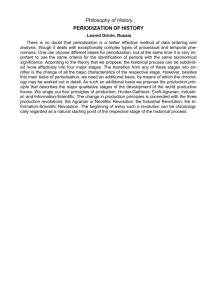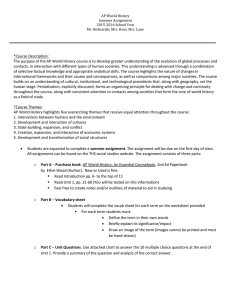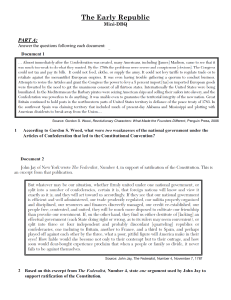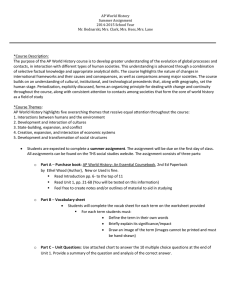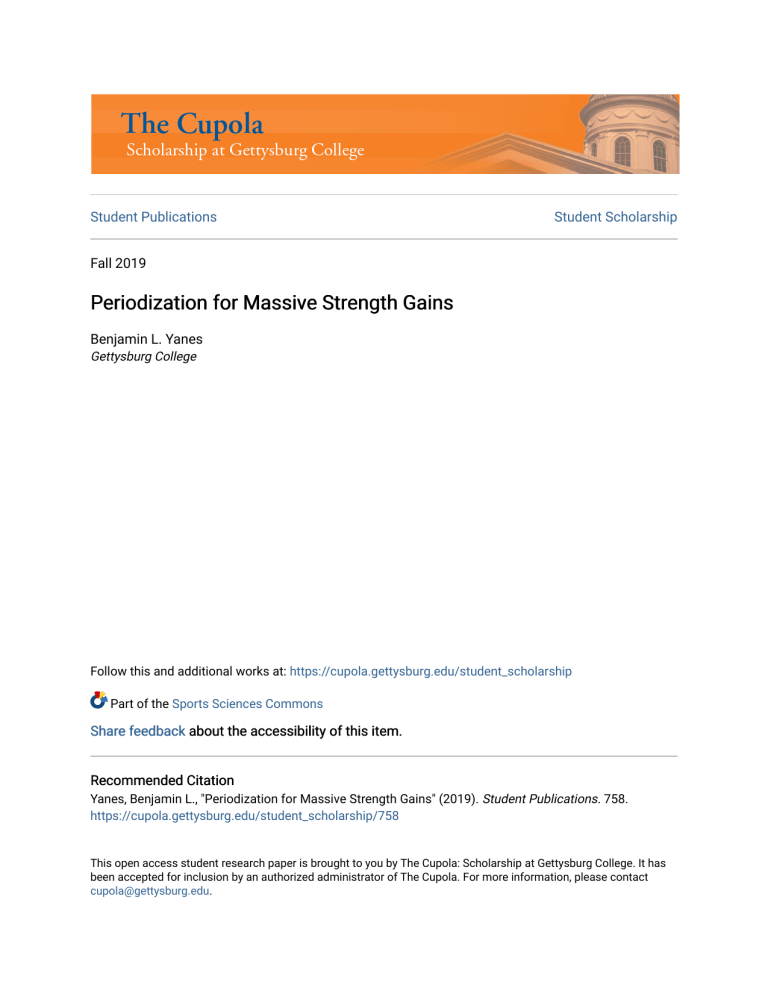
Student Publications Student Scholarship Fall 2019 Periodization for Massive Strength Gains Benjamin L. Yanes Gettysburg College Follow this and additional works at: https://cupola.gettysburg.edu/student_scholarship Part of the Sports Sciences Commons Share feedback about the accessibility of this item. Recommended Citation Yanes, Benjamin L., "Periodization for Massive Strength Gains" (2019). Student Publications. 758. https://cupola.gettysburg.edu/student_scholarship/758 This open access student research paper is brought to you by The Cupola: Scholarship at Gettysburg College. It has been accepted for inclusion by an authorized administrator of The Cupola. For more information, please contact cupola@gettysburg.edu. Periodization for Massive Strength Gains Abstract In order to create the perfect resistance training program for their athletes, coaches must master the ability to control all variables of training over time in order to maximize physiological responses - this is a concept known as periodization (3, 6, 7, 8, 9, 10, 19, 21, 24, 25, 26). Periodization was first established in Russia, after the conclusion of the 1956 Olympic games (7, 21). Though simple in its principle and aim, periodization is frequently misunderstood due to the hyperspecific research that surrounds it (3, 4, 7, 8, 10, 15, 21, 23, 25). Over the last five decades, researchers have produced a multitude of studies that look at specific variables of periodization, which this paper will later examine, but many of them prove to be inconclusive due to uncontrollable factors outside of training (3, 4, 7, 8, 13, 14, 19, 21). These uncontrollable factors make it difficult to be absolute in any conclusions surrounding the topic of periodization, though there are a number of considerations that make periodization very valuable (25). Periodization is of paramount importance when creating resistance training plans due to its role in the manipulation and subsequent control of variables over time (3, 6, 7, 8, 9, 10, 19, 21, 24, 25, 26). Without control of variables, resistance training becomes an aimless and non goal-oriented task (25, 43). In comparison with non-periodized resistance programs, periodized plans prove to be significantly more effective in strength gained, lean mass gained, and percent body fat lost (1, 5, 6, 11, 15, 25). Periodization will likely remain a topic of controversy for a long time to come, as coaches continue to seek the most effective combination and manipulation of training variables at their disposal (23). Keywords Periodization, Strength, Gains Disciplines Medicine and Health Sciences | Sports Sciences Comments Written for HS 311: Neuromuscular Physiology. Creative Commons License This work is licensed under a Creative Commons Attribution 4.0 License. This student research paper is available at The Cupola: Scholarship at Gettysburg College: https://cupola.gettysburg.edu/student_scholarship/758 Yanes 1 Periodization for Massive Strength Gains Ben Yanes Dr. Drury Neuromuscular Physiology 26 November 2019 Yanes 2 INTRODUCTION In order to create the perfect resistance training program for their athletes, coaches must master the ability to control all variables of training over time in order to maximize physiological responses - this is a concept known as periodization (3, 6, 7, 8, 9, 10, 19, 21, 24, 25, 26). Periodization was first established in Russia, after the conclusion of the 1956 Olympic games (7, 21). Though simple in its principle and aim, periodization is frequently misunderstood due to the hyper-specific research that surrounds it (3, 4, 7, 8, 10, 15, 21, 23, 25). Over the last five decades, researchers have produced a multitude of studies that look at specific variables of periodization, which this paper will later examine, but many of them prove to be inconclusive due to uncontrollable factors outside of training (3, 4, 7, 8, 13, 14, 19, 21). These uncontrollable factors make it difficult to be absolute in any conclusions surrounding the topic of periodization, though there are a number of considerations that make periodization very valuable (25). Periodization is of paramount importance when creating resistance training plans due to its role in the manipulation and subsequent control of variables over time (3, 6, 7, 8, 9, 10, 19, 21, 24, 25, 26). Without control of variables, resistance training becomes an aimless and non goal-oriented task (25, 43). In comparison with non-periodized resistance programs, periodized plans prove to be significantly more effective in strength gained, lean mass gained, and percent body fat lost (1, 5, 6, 11, 15, 25). Periodization will likely remain a topic of controversy for a long time to come, as coaches continue to seek the most effective combination and manipulation of training variables at their disposal (23). Yanes 3 TRAINING PRINCIPLES General Adaptation Syndrome, known as GAS, states that, when exposed to stress, three phases of adaptation will occur: the alarm phase, the resistance phase, and the exhaustion phase (7, 23). The alarm phase occurs when the athlete will experience mild fatigue or a decrease in performance (23). The resistance phase occurs when the body naturally responds to the stressor by adapting with less soreness and an improved performance (also known as supercompensation) (23). Finally, if the individual is unable to adapt to the stress, the exhaustion phase occurs (7, 23). There are several implications of GAS principle when considering periodization for athletes; one of the most important is the ability to regulate one’s fatigue properly over a long period of time (7, 10, 15, 23). Fatigue management is controlled by manipulating the training variables of volume, intensity, and frequency - which will be discussed later in this paper - and their relationship to the principle of overload (25). The principle of overload states that any individual who is exposed to training that goes beyond normal levels of physical performance will adapt to be able to achieve that higher level of performance in future exercise bouts (5, 11, 19, 24, 27, 28, 29). As the GAS principle indicates, when an individual continues to make gains from an exercise program, they will need to introduce more challenging stimuli in order to continue in their progression (28, 29). As muscles increase in both size and strength over time, they will naturally be able to produce more force and thus accrue more gain (25, 28, 29). This involves the concept of progressive overload, which states that, to continue creating Yanes 4 adaptation, the individual must increase stress to the muscle over time that is proportional to that of the progress made (5, 24, 27, 28). In order to progressively overload effectively, one must properly apply the principle of specificity to their training, which states that the adaptations that one experiences in training are specific to the stress provided (27, 28, 29). The principle of specificity dictates which specific adaptations that an individual will acquire through their training, so it plays an imperative role in the overall picture of periodization (27, 28, 29). Additionally, the specificity of exercise dictates which muscle groups and movement patterns will be primarily developed through exercise (28). An example of this would be a baseball pitcher addressing a weak point in his shoulder through selecting exercises that involve the rotator cuff muscles in order to improve the circumductive nature of the throwing motion (28). After having trained specific movement patterns over a sustained period of time, the individual will adapt and will need new stimuli to continue getting stronger (20, 27, 29, 30). Variation in a resistance training program refers to the changing of variables including weight used (intensity), volume performed, type of contraction, and speed of contraction through different blocks of training (29). Additionally, manipulation of these variables in the short term potentially reduces stress on certain muscle groups, thereby promoting supercompensation (27). Variation in resistance training may also create greater adherence of the individual to their program due to the novelty behind learning new movements (30). Variation in periodization is what allows the individual to continually adapt without becoming stuck at significant plateaus in strength gains (20, 27, 29, 30). The principle of variation also directly impacts the principle of individuality, Yanes 5 which states that each athlete may respond differently to the same stimulus based on his or her genetic predispositions to gain strength (42). The principle of individuality dictates that coaches should utilize variation in order to uncover what stimuli are optimal for each athlete (42). It also says that the athlete must vary exercise selection, volume, intensity, and frequency depending on their individual needs (42). THE FITNESS-FATIGUE MODEL The fitness-fatigue model of training describes the relationship between an athlete’s performance and their level of fatigue (44). Fatigue is defined as maladaptation to a training stimulus which, if managed properly, can later be attributed to an increase in performance following the GAS principle (7, 23, 44, 45). The fitness fatigue model states that, after a significant amount of acute stress to the body, fatigue will initially increase and performance will decrease (44, 45). After proper recovery, fatigue will decrease, and performance will increase (44, 45). After a period of time, if fatigue accumulates beyond the individual’s recoverable capacity, overtraining will occur and performance will significantly decrease (28, 29, 44, 45). Performance will benefit, however, from a short-term period of overreaching, wherein an excessive amount of stimulus is placed on the individual followed by a period of recovery (6, 8, 21, 23, 25, 44, 45). This results in an acute increase in performance, and is typical of athletes such as powerlifters or weightlifters who need to be at peak levels of fitness on one particular day of the year (44, 45). This is why manipulating the variables of volume, intensity, and frequency are of paramount importance to increasing strength (3, 6, 7, 8, 9, 10, 19, 21, 24, 25, 26). Yanes 6 TERMINOLOGY: VOLUME, INTENSITY, FREQUENCY Volume is defined as the total amount of work performed as either sets multiplied by reps and load (tonnage), or simply as sets multiplied by reps (6, 10, 18,19, 20, 24). Volume is an essential component of any periodization model, given that it needs to be balanced in tandem with intensity (25). Intensity simply refers to the amount of weight used in a given exercise (10, 18, 19, 20, 23, 25, 27, 30). Depending on the phase and goal of a training cycle, the relationship between volume and intensity will change (25, 26). For example, if the athlete is in a hypertrophy phase (muscle-building phase), overall volume will be higher, and intensity will be lower (10, 18, 19, 25, 26, 27). If the athlete is in a strength or power phase (a phase wherein gaining strength or power is the primary goal), in general, prescribed intensities will be higher and volume will be lower (10, 18, 19, 25, 26, 27). Frequency simply refers to the amount of times per week or month that a specific exercise is performed (6, 10, 25, 26, 27). Generally speaking, the recommended frequencies per muscle group per week is two to three times, though this will vary depending on individual physiological responses and variables outside of training such as scheduling and free time available (6, 25, 26, 34, 35, 36). The balance of volume, intensity, and frequency are the building blocks of any periodized program (25, 31). Manipulating these variables within each week and month allow athletes to aim and achieve their individual goals (25, 31, 32, 34, 25). Recommendations for starting points are as follows: if the primary goal is hypertrophy, 10-20 sets per muscle group per week, with a 2x per week frequency, and with ⅔-¾ of Yanes 7 total volume in the 6-12 repetition range, with the remaining volume in the 1-6 and 1220 repetition range (25, 31, 32, 33). If the primary goal in training is strength, frequency and total sets remain the same, while ⅔-¾ of the volume should be in the 1-6 repetition range and the remaining volume in the 6-20 repetition range (25, 31, 32, 33). TERMINOLOGY: MICROCYCLES, MESOCYCLES, AND MACROCYCLES A microcycle is defined as a short period of training, typically one to four weeks (most often one or two) (9, 10, 18, 19, 20, 26). A mesocycle is defined as a period of training between one to four months (9, 10, 18, 19, 20, 26). A macrocycle is defined as a period of training between 9-12 months (9, 10, 18, 19, 20, 26). Properly planned micro and meso cycles, which constitute the macrocycle plan, take into account volume, intensity, and frequency in relation to the individual’s goals in training (9, 10, 18, 19, 25, 26). MODELS OF PERIODIZATION - LINEAR Linear periodization, otherwise known as Western periodization, is a model of progression that begins with higher volumes and lower intensities across all exercises and gradually moves towards lower volumes and higher intensities across all exercises (2, 3, 5, 6, 8, 10, 11, 12, 13, 15, 16, 18, 21, 23, 24, 25). During the commencement of a linearly periodized program, higher rep ranges, lower intensities and fewer sport-specific movements (namely for individual strength athletes) should be utilized to achieve physiological adaptations such as muscular endurance and hypertrophy (2, 8, 23, 24, 25). Both muscular hypertrophy and muscular endurance play imperative roles in Yanes 8 increasing strength and power potential through increased cross-sectional area as well as increased work capacity of the muscle fibers (2, 8, 23, 24, 25). These adaptations will have great carryover to further adaptations such as strength and power in later phases of training where more specific movements will be used (for individual strength sport athletes) and lower overall volume will be accumulated (2, 8, 23, 24, 25). It is important to recognize that linear periodization, as well as all other models of periodization, were created to be adapted to each athlete’s sport-specific requirements (25). An example of this is a model of linear periodization that begins with a volume phase, where intensities are low and volume is high, transitions into a strength phase, where volume decreases and intensity increases, and ends with a power phase, where both intensity and volume decrease (21, 23, 24, 25). This could apply to an athlete such as a football player, who needs to transfer maximal power adaptations into the start of the season, but who also needs to reduce fatigue at the same time by decreasing volume and intensity over time (21, 23, 24, 25). This kind of model would not apply to a strength athlete such as a powerlifter, who needs to continue working with higher intensities and decreased volumes leading up to a taper prior to competition (21, 23, 24, 25). Linear periodization is not without its limitations, however. Given the long phasic nature of the linear model, certain adaptations, such as muscular hypertrophy, are difficult to maintain in later phases of training (21, 23). This is likely due to a disuse of the adaptation achieved over a long period of time (21, 23). Additionally, linear periodization does not take into account the in-season taxes to the athlete’s recovery; Yanes 9 athletes are not able to ‘peak’ a particular adaptation during their season due to fatigue accumulated from their sport (21, 23, 25). MODELS OF PERIODIZATION - BLOCK Block periodization is a training model that divides the macrocycle into 3-4 mesocycles (blocks) that are each designated to achieve specific adaptations (2, 6, 8, 9, 14, 21, 23, 25). Though block periodization shares many elements with linear periodization, such as varying volumes and intensities, the periods of time (the mesocycles) in which specific adaptations are focused are much shorter; in linear periodization, mesocycles typically last several months, whereas in block periodization, mesocycles last 4-6 weeks (2, 6, 8, 9, 14, 21, 23, 25). This allows athletes who need to be in peak condition multiple times a year, such as a powerlifter or sprinter, to plan these shorter blocks based on competition dates (25). An example of a block-periodized program would begin with a higher volume, lower intensity block, and would continue with a lowered volume, higher intensity block, culminating in a taper (a period of time to decrease either volume, intensity, or both in order to supercompensate) to peak performance (6, 8, 21, 23, 25). Outside of the shorter mesocycle plans, block periodization is similar to linear periodization in its fundamental elements (2, 6, 8, 9, 21, 23, 25). MODELS OF PERIODIZATION - UNDULATING Undulating periodization is a form of periodization that utilizes more frequent changes to volume, intensity, and repetition ranges (3, 5, 6, 10, 11, 12, 13, 14, 15, 16, Yanes 10 17, 22, 23, 25). Daily undulating periodization (DUP) changes these variables on a daily basis (throughout the microcycle), while weekly undulating periodization changes these variables every week (5, 15, 25). Like block periodization, DUP and WUP attempt to eliminate the potential downfalls of disuse to muscular adaptation that linear periodization creates, and like linear periodization, undulating programs follow a progression of focusing on hypertrophy, then strength, and finally power (5, 15, 21, 23, 25). An example of a DUP progression would be training hypertrophy on the first day of the week, then strength two days later, and finally hypertrophy another two days later (5, 15, 21, 23, 25). A WUP model would follow this same progression, except in a weekly instead of daily progression (5, 15, 21, 23, 25). MODELS OF PERIODIZATION - A COMPARISON AND CLOSER LOOK Though there are a multitude of studies comparing the popular models of periodization, the answer as to the question of which model is best remains uncertain (25). Several studies have directly compared the effects on gaining strength using linear periodization against daily and weekly undulating periodization (3, 5, 6, 10, 11, 12, 13, 15, 16, 23, 25, 37). In a number of these studies, the groups that utilized undulating periodization over short (4-6 weeks) and long (12+ weeks) periods of time were shown to increase their overall strength at a greater rate than groups that utilized linear periodization (10, 11, 15). There were a number of other studies, however, that concluded that there were no differences in strength gains, provided that total volume across all exercises was equated (13, 16, 23, 37). Other studies have also looked at the comparisons between block-periodized programs and linear-periodized programs (2, 8, Yanes 11 9, 21, 23). Some of these studies conclude that block-periodized models result in greater strength gains than linear-periodized models (2, 8, 21, 23). It is worth noting, however, that many of these conclusions are based off of short-term findings that lead researchers to make statements such as “these findings suggest that BP (block periodization) may be more effective than TP (traditional periodization)” (2). Very few studies have looked into the comparison between block-periodized programs and undulating programs, but the ones that have show a greater increase in overall strength in the block periodized groups when volume was equated (38). It is difficult to discern which model of periodization will result in the greatest amount of strength gains for a number of reasons. The first reason is that there is a very limited amount of data that shows that one model of periodization is superior to another (39). The second reason is that, while there are trends that lead us to believe one model may be superior to another, as in the comparison between linear periodization and DUP/WUP, there are always other cases that show the exact opposite or that are inconclusive (3, 5, 6, 10, 11, 12, 13, 15, 16, 23, 25, 37, 39). The third, and perhaps most notable reason, is that there are an infinite number of ways that one can design a linear, block, or undulating model (25, 39). Many coaches design programs that are a combination of these models, and this is what makes it difficult to truly isolate one method versus another (25, 39). Because every periodization model should be linear in nature, meaning that the individual is improving in some measurable way over time, and because different athletes may need varying volumes and intensities throughout different periods of time (that come in blocks), research suggests that an approach that combines these models of periodization will be best (39, 40, 41). Yanes 12 References 1) Kraemer, W. J., Ratamess, N., Fry, A. C., Triplett-McBride, T., Koziris, L. P., Bauer, J. A., … Fleck, S. J. (2000). Influence of Resistance Training Volume and Periodization on Physiological and Performance Adaptations in Collegiate Women Tennis Players. The American Journal of Sports Medicine, 28(5), 626– 633. https://doi.org/10.1177/03635465000280050201 2) Manchado, C., Cortell-Tormo, J., & Tortosa-Martínez, J. (n.d.). Effects of Two Different Training Periodization Models on Physical and Physiological Aspects of Elite Female Team Handball Players. Journal of Strength and Conditioning Research, 32(1), 280–287. https://doi.org/10.1519/JSC.0000000000002259 3) Buford, T., Rossi, S., Smith, D., & Warren, A. (2007). A comparison of periodization models during nine weeks with equated volume and intensity for strength. Journal of Strength and Conditioning Research, 21(4), 1245–1250. https://doi.org/10.1519/R-20446.1 4) Rhea, M., & Alderman, B. (2004). A meta-analysis of periodized versus nonperiodized strength and power training programs. Research Quarterly for Exercise and Sport., 75(4), 413–422. https://doi.org/10.1080/02701367.2004.10609174 5) Baker, D., Wilson, G., & Carlyon, R. (1994). Periodization: The Effect on Strength of Manipulating Volume and Intensity. The Journal of Strength and Conditioning Research, 8(4), 235. Doi: 10.1519/1533-4287(1994)008<0235:pteoso>2.3co;2 6) Williams, T. D., Tolusso, D. V., Fedewa, M. V., & Esco, M. R. (2017). Comparison of periodized and non-periodized resistance training on maximal strength: A meta-analysis. Sports Medicine, 47(10), 2083. doi:http://dx.doi.org/10.1007/s40279-017-0734-y 7) Nuckols, G. (2017). Periodization: History and Theory. Stronger By Science. Retrieved from https://www.strongerbyscience.com/periodization-history-theory/ 8) Bartolomei, S., Hoffman, J. R., Merni, F., & Stout, J. R. (2014). A Comparison of Traditional and Block Periodized Strength Training Programs in Trained Athletes. Journal of Strength and Conditioning Research, 28(4), 990–997. doi: 10.1519/jsc.0000000000000366 9) Issurin, V. (n.d.). Block periodization versus traditional training theory: a review. J Sports Med Phys Fitness, 48, 65–75. Retrieved from https://www.researchgate.net/profile/Vladimir_Issurin4/publication/5638447_Bloc k_periodization_versus_traditional_training_theory_A_review/links/59a4f8074585 157031179b96/Block-periodization-versus-traditional-training-theory-A-review.pdf 10) Rhea, M. R., Ball, S. D., Phillips, W. T., & Burkett, L. N. (2002). A Comparison of Linear and Daily Undulating Periodized Programs with Equated Volume and Yanes 13 Intensity for Strength. The Journal of Strength and Conditioning Research, 16(2), 250. doi: 10.1519/1533-4287(2002)016<0250:acolad>2.0.co;2 11) Brown, L. E., Bradley-Popovich, G. E., & Haff, G. G. (2001). Nonlinear versus linear periodization models. Strength Cond J, 23(1), 42-44. 12) Ahmadizad, S., Ghorbani, S., Ghasemikaram, M., & Bahmanzadeh, M. (2014). Effects of short-term nonperiodized, linear periodized and daily undulating periodized resistance training on plasma adiponectin, leptin and insulin resistance. Clinical biochemistry, 47(6), 417-422. 13) Harries, S. K., Lubans, D. R., & Callister, R. (2015). Systematic review and metaanalysis of linear and undulating periodized resistance training programs on muscular strength. The Journal of Strength & Conditioning Research, 29(4), 1113-1125. 14) Painter, K. B., Haff, G. G., Ramsey, M. W., McBride, J., Triplett, T., Sands, W. A., ... & Stone, M. H. (2012). Strength gains: Block versus daily undulating periodization weight training among track and field athletes. International journal of sports physiology and performance, 7(2), 161-169. 15) Prestes, J., Frollini, A. B., de Lima, C., Donatto, F. F., Foschini, D., de Cássia Marqueti, R., ... & Fleck, S. J. (2009). Comparison between linear and daily undulating periodized resistance training to increase strength. The Journal of Strength & Conditioning Research, 23(9), 2437-2442. 16) Franchini, E., Branco, B. M., Agostinho, M. F., Calmet, M., & Candau, R. (2015). Influence of linear and undulating strength periodization on physical fitness, physiological, and performance responses to simulated judo matches. The Journal of Strength & Conditioning Research, 29(2), 358-367. 17) Zourdos, M. C., Jo, E., Khamoui, A. V., Lee, S. R., Park, B. S., Ormsbee, M. J., ... & Kim, J. S. (2016). Modified daily undulating periodization model produces greater performance than a traditional configuration in powerlifters. The Journal of Strength & Conditioning Research, 30(3), 784-791. 18) Plisk, S. S., & Stone, M. H. (2003). Periodization strategies. Strength & Conditioning Journal, 25(6), 19-37. 19) Stone, M. H., O'bryant, H. S., Schilling, B. K., Johnson, R. L., Pierce, K. C., Haff, G. G., & Koch, A. J. (1999). Periodization: effects of manipulating volume and intensity. Part 1. Strength & Conditioning Journal, 21(2), 56. 20) Stone, M. H., O'bryant, H. S., Schilling, B. K., Johnson, R. L., Pierce, K. C., Haff, G. G., & Koch, A. J. (1999). Periodization: effects of manipulating volume and intensity. Part 2. Strength & Conditioning Journal, 21(3), 54. 21) Issurin, V. B. (2010). New horizons for the methodology and physiology of training periodization. Sports medicine, 40(3), 189-206. 22) Monteiro, A. G., Aoki, M. S., Evangelista, A. L., Alveno, D. A., Monteiro, G. A., da Cruz Piçarro, I., & Ugrinowitsch, C. (2009). Nonlinear periodization maximizes Yanes 14 strength gains in split resistance training routines. The Journal of Strength & Conditioning Research, 23(4), 1321-1326. 23) Lorenz, D., & Morrison, S. (2015). CURRENT CONCEPTS IN PERIODIZATION OF STRENGTH AND CONDITIONING FOR THE SPORTS PHYSICAL THERAPIST. International journal of sports physical therapy, 10(6), 734–747. 24) Lorenz, D. S., Reiman, M. P., & Walker, J. C. (2010). Periodization: current review and suggested implementation for athletic rehabilitation. Sports health, 2(6), 509–518. doi:10.1177/1941738110375910 25) Helms, E., Morgan, A., & Valdez, A. (2018). The Muscle & Strength Pyramid(2nd ed.). 26) Fleck, S. J., & Kraemer, W. J. (1996). The Ultimate Training System: Periodization Breakthrough!(1st ed.). New York, NY: Advanced Research Press. 27) Kavanaugh, A. (2007). The Role of Progressive Overload in Sports Conditioning. Conditioning Foundamentals. NSCA’s Performance Training Journal, 6(1). 28) Cissik, J. M. (2002). Basic principles of strength training and conditioning. NSCA’s Performance Training Journal, 1(4), 7-11. 29) Stone, M. H., Collins, D., Plisk, S., Haff, G., & Stone, M. E. (2000). Training principles: Evaluation of modes and methods of resistance training. Strength & Conditioning Journal, 22(3), 65. 30) Poliquin, C. (1988). FOOTBALL: Five steps to increasing the effectiveness of your strength training program. National Strength & Conditioning Association Journal, 10(3), 34. doi: 10.1519/0744-0049(1988)010<0034:fstite>2.3.co;2 31) Schoenfeld, B. J., Contreras, B., Vigotsky, A. D., & Peterson, M. (2016). Differential Effects of Heavy Versus Moderate Loads on Measures of Strength and Hypertrophy in Resistance-Trained Men. Journal of sports science & medicine, 15(4), 715–722. 32) Schoenfeld, B. J., Peterson, M. D., Ogborn, D., Contreras, B., & Sonmez, G. T. (2015). Effects of Low- vs. High-Load Resistance Training on Muscle Strength and Hypertrophy in Well-Trained Men. Journal of Strength and Conditioning Research, 29(10), 2954–2963. doi: 10.1519/jsc.0000000000000958 33) Schoenfeld, B. J., Ratamess, N. A., Peterson, M. D., Contreras, B., Sonmez, G. T., & Alvar, B. A. (2014). Effects of Different Volume-Equated Resistance Training Loading Strategies on Muscular Adaptations in Well-Trained Men. Journal of Strength and Conditioning Research, 28(10), 2909–2918. doi: 10.1519/jsc.0000000000000480 34) Ralston, G. W., Kilgore, L., Wyatt, F. B., & Baker, J. S. (2017). The Effect of Weekly Set Volume on Strength Gain: A Meta-Analysis. Sports medicine (Auckland, N.Z.), 47(12), 2585–2601. doi:10.1007/s40279-017-0762-7 35) Schoenfeld, B. J., Ogborn, D., & Krieger, J. W. (2016). Dose-response relationship between weekly resistance training volume and increases in muscle Yanes 15 mass: A systematic review and meta-analysis. Journal of Sports Sciences, 35(11), 1073–1082. doi: 10.1080/02640414.2016.1210197 36) Timmons J. A. (2011). Variability in training-induced skeletal muscle adaptation. Journal of applied physiology (Bethesda, Md. : 1985), 110(3), 846–853. doi:10.1152/japplphysiol.00934.2010 37) Kok, L. Y., Hamer, P. W., & Bishop, D. J. (2009). Enhancing Muscular Qualities in Untrained Women: Linear versus Undulating Periodization. Med Sci Sport Exerc, 41(9), 807–1797. doi: 10.1249/MSS.0b013e3181a154f3. 38) Painter, K. B., Haff, G. G., Ramsey, M. W., Mcbride, J., Triplett, T., Sands, W. A., … Stone, M. H. (2012). Strength Gains: Block Versus Daily Undulating Periodization Weight Training Among Track and Field Athletes. International Journal of Sports Physiology and Performance, 7(2), 161–169. doi: 10.1123/ijspp.7.2.161 39) Kiely, J. (2012). Periodization Paradigms in the 21st Century: Evidence-Led or Tradition-Driven? International Journal of Sports Physiology and Performance, 7(3), 242–250. doi: 10.1123/ijspp.7.3.242 40) Zourdos, M. C., Klemp, A., Dolan, C., Quiles, J. M., Schau, K. A., Jo, E., … Blanco, R. (2016). Novel Resistance Training–Specific Rating of Perceived Exertion Scale Measuring Repetitions in Reserve. Journal of Strength and Conditioning Research, 30(1), 267–275. doi: 10.1519/jsc.0000000000001049 41) Willoughby, D. S. (1993). The Effects of Mesocycle-Length Weight Training Programs Involving Periodization and Partially Equated Volumes on Upper and Lower Body Strength. The Journal of Strength and Conditioning Research, 7(1), 2. doi: 10.1519/1533-4287(1993)007<0002:teomlw>2.3.co;2 42) Cox, R. (2007). Oxford Dictionary of Sports Science and Medicine (3rd edition)2007342Michael Kent. Oxford Dictionary of Sports Science and Medicine (3rd edition). Oxford: Oxford University Press 2006. vii 612 pp., ISBN: 978 0 19 856850 6. Reference Reviews, 21(7), 50–50. doi: 10.1108/09504120710821848 43) Fishbach, A., & Choi, J. (2012). When thinking about goals undermines goal pursuit. Organizational Behavior and Human Decision Processes, 118(2), 99– 107. doi: 10.1016/j.obhdp.2012.02.003 44) Chiu, L. Z., & Barnes, J. L. (2003). The Fitness-Fatigue Model Revisited. Strength and Conditioning Journal, 25(6), 42–51. doi: 10.1519/00126548200312000-00007 45) Pistilli, E.E., Kaminsky, D.E., Totten, L., & Miller, D. (2008). Incorporating One Week of Planned Overreaching into the Training Program of Weightlifters.
